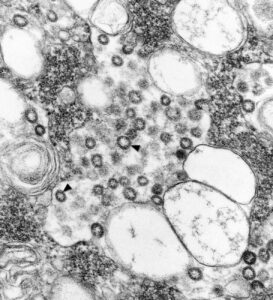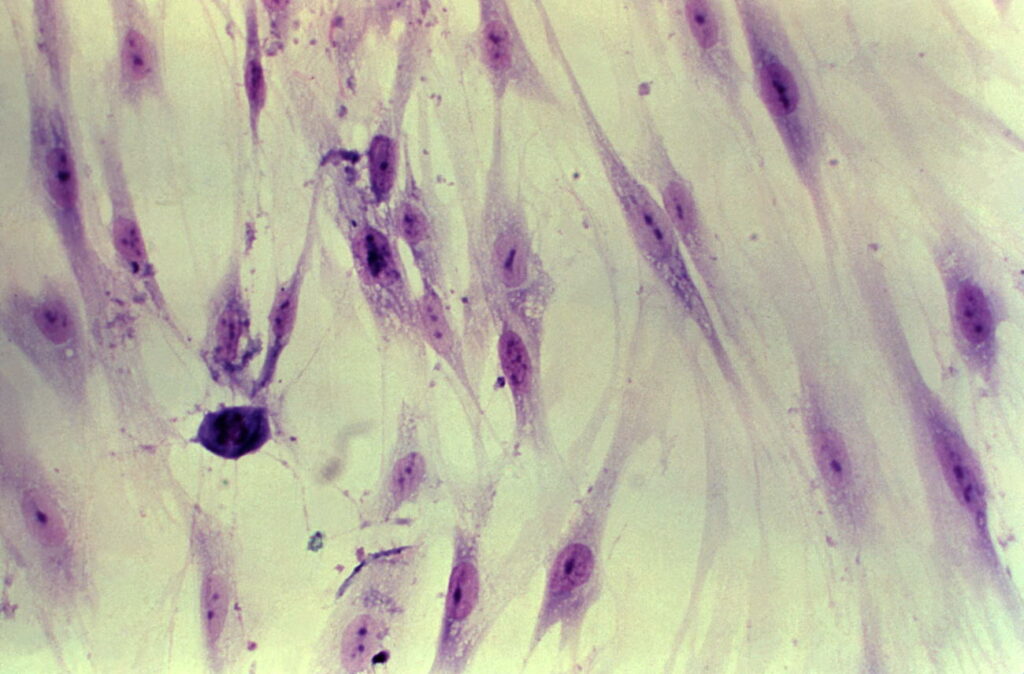Above is a 1980 photograph of a pristine fibroblast cell strain called Medical Research Council cell strain 5, MRC-5 which was developed in the United Kingdom in 1966. Below is a thin section transmission electron micrograph of MRC-5 cells which show SARS-CoV-1 inside the infected cells. From phil.cdc.com and in the public domain.

The Fetal Cell Strain Controversy in Vaccine Development
Introduction
The most controversial issue, at least in my own heart, is the use of cell strains for research and vaccine production. Most people know little about why cell strains are important for that, or how cell strains came about. Vaccine objectors quip that they contain aborted fetal tissue, and decry their use in order to promote their agenda. Nothing could be further from the truth.
What they don’t know or intentionally refuse to see, is how complicity we all are in today’s abortion industry.
A Brief History Cell Strains and Vaccine Development
On January 22, 1973, the Supreme Court struck down a Texas ban on abortion in Roe v. Wade. Like me, you may have thought that is when the abortion industry started. In the 1930s, abortion was very much illegal for almost all reasons everywhere in the US. Still, there were perhaps 800,000 or more back-room procedures performed that year. Some were done for medical reasons without prosecution.1 2 3 4
In thirty-six years of primary care pediatrics with some level III neonatology, I never knew or heard of any colleagues doing abortions. Personally and professionally, I abhorred it. Physicians had no formal education or training in the procedure when I was in medical school in the early 1980s. I was never taught about the history of cell strains then either. The few vaccines that were available when I started private practice in 1986 included DTP (whole cell pertussis, diphtheria, and tetanus), oral polio, and the MMR (measle, mumps, and rubella).
The polio and MMR vaccines all came about as a result of human cell strain development. Unlike bacteria, viruses are simply dead nucleotide sequences without the host’s biochemical machinery to reproduce. They exist to replicate, but outside the host cell they are nothing. Prions are similar though they are proteins and not nucleotides. In order to produce a viral vaccine, you must have virus and host cells in which they can multiply.
Sabin and Olitsky struggled to grow polio in any cells besides those from neural tissue.5 Vaccines made from neural tissue sometimes included small amounts of myelin basic protein. In some people, this protein triggered encephalomyelitis, and some died. Neural tissues therefore could not be used to culture and grow polio.
But the virus refused to grow in anything other than neural cells. Sabin finally gave up after working to cultivate the virus for many years. In 1948, Enders, Weller, and Robbins discovered that the polio strain Sabin was using was the problem. Using the Lansing strain, Weller and his colleagues were able to culture polio virus.6
But succesful viral culture was problematic. Non-human cells from monkeys used to make the first polio vaccine was discovered to contain SV40 (Simian Virus 40). This virus wasn’t even know until after vast number of children had been injected with the polio vaccine containing it. Fortunately, the SV40 was shown after decades of post-vaccination follow-up to be harmless in humans. Concern was well founded, since it was know that some cancers in animals were caused by viruses. The Cutter incident was not so forgiving. Improper filtering at Cutter Laboratories in Berkely, California, a license polio vaccine manufacturer, resulted in the presence of live polio virus in some of its lots. Many vaccinated children came down with polio, and almost two hundred died. Between the reactions to myelin basic protein, the non-human, and human virus contaminants plaguing vaccines, use of non-human cells for vaccine production was halted by the FDA. The concensus was that a vaccine could only be safe if it grew in a human cell strain.
In 1961, human cell strains became available for viral culture. Working at the Wistar Institute at the University of Pennsylvania in Philadelphia, Leonard Hayflick received the lungs of a fetus aborted in Sweden from Dr. Sven Gard the top virologist at the Karolinska Institute in Solna (Stockholm), Sweden. The child’s mother, who already had six children with their derelict alcoholic father, elected to terminate the baby. This mother, as far as I know, was not solicited with the intent of harvesting fetal cells from her unborn baby. Most Swedish physicians at that time frowned on abortion, even though it was legal there.7
Hayflick teased the fetal lung tissue down to pinhead-sized specks, then treated them with digestive enzymes from pigs to loosen the cells from one another. In his nutrient-rich flasks, the cells began to replicate, and Hayflick named them the WI-38 cell strain. Ultimately, about 800 nutrient-rich flasks each with nearly 2 million cells each were created. By Hayflick’s calculations, that was enough cells to produce 22 million tons of cells, more than enough he thought to last almost indefinitely.8 Contrary to previous thought, Hayflick knew that these cells had a limited number of replications, perhaps about 40 to 50. Cell strains are not immortal like cell lines. Cell lines come from cancerous cells, the most famous probably being the HeLa line which was named after Henrietta Lacks who died from the cancer.
Cancer cell lines could cause cancer if used for viral cultivation, production, and vaccination. At that time, the only source of pristine cells for viral culture which was free from abnormal DNA and other viral infections was the WI-38 strain. In 1966, the MRC-5 cell strain was subsequently produced by the Medical Research Council in London as a British competitor to the Hayflick’s WI-38 strain. All cell strains are normal cells, which is a requirement for vaccine production, but they have a limited number of replications unless they have their DNA altered. In other words, they stop replicating just like they do in our body. The WI-38 strain is coming to an end since it doesn’t have many more replications left. WI-38 will eventually die out, as will MRC-5.
The MRC-5 and the WI-38 cell strains are responsible for an inestimable number of vaccine doses, and have prevented hundreds of millions of cases of various diseases. Each cell strain came from one fetus. It is absolutely false to believe that today’s vaccines contain fetal tissues from yesterday’s aborted babies.
Are Vaccines Complicit in the Abortion Industry?
Personal conscience about using vaccines created or developed with cell strains remains a large and insurmountable moral issue for some. The whole abortion issue is painful even for me. Some see vaccines as a conspiracy, or even tout them as evil. My personal abhorrence to abortion runs deep, and to understand why, you can read mine and Stacy’s story online here.9
As far as I know, no one tried to induce the mother’s of the two babies to abort in order to make these cell strains. It appears in fact, that the mother of the baby whose lung tissue gave rise to Hayflick’s WI-38 cell strain was never told about it, and probably assumed the remains of her child were incinerated.10 As I’ve pointed out, even though abortion wasn’t legal in the US, it was in Sweden at the time, and abortion was much more common than we may think. Out of sight is out of mind though, and we are all much closer to supporting abortion even if we or our children never received any vaccines.
Since vaccines contain no aborted fetal tissues, pointing the moral finger at them is hypocritical. Everyday we all indirectly support abortion. An online search for companies that contribute to the abortion industry resulted in a startling list of direct and indirect corporate donors to Planned Parenthood. 11 Do those who oppose vaccination recognize that by trading with these companies, they are indirectly complicit? Are we all complicit when we do business with these corporations? Vaccines absolutely do not contribute to today’s abortion industry, but doing business with corporate abortion donors makes all of us complicit.
So then, what is the solution? Do we create a non-abortion currency, so we can clearly see which dollar bill has not been used to pay for abortions? Vaccine opponents excuse themselves, all the while protesting the use of fetal cell strains in viral manufacture. Who really bears the guilt here? Certainly it is not cell strains used for vaccine culture intended to preserve life.
Table 1. The following companies have contributed money directly to Planned Parenthood. You will take notice some pharmaceutical companies, one of the which manufacturers the SARS-CoV-2 mRNA vaccine.12
Bibliography
ENDNOTES
- Gold RB. Lessons from Before Roe: Will Past be Prologue? The Guttmacher Report on Public Policy. 2003;(6):8-11. doi:10.1363/2020.31675 ↩
- Nossiff R. Before Roe: Abortion Policy in the States. Temple University Press; 2001. ↩
- Gold RB. Lessons from Before Roe: Will Past be Prologue? The Guttmacher Report on Public Policy. 2003;(6):8-11. doi:10.1363/2020.31675 ↩
- Wadman M. The Vaccine Race: Science, Politics, and the Human Costs of Defeating Disease. Viking; 2017, p 24. ↩
- Sabin AB, Olitsky PK. Cultivation of Poliomyelitis Virus in vitro in Human Embryonic Nervous Tissue. Proceedings of the Society for Experimental Biology and Medicine. 1936;34(3):357-359. http://doi.org/10.3181/00379727-34-8619C ↩
- Enders JF, Weller TH, Robbins FC. Cultivation of the Lansing Strain of Poliomyelitis Virus in Cultures of Various Human Embryonic Tissues. Science. 1949;109(2822):85-87. Accessed May 13, 2021. https://www.jstor.org/stable/1676381 ↩
- Wadman M. The Vaccine Race: Science, Politics, and the Human Costs of Defeating Disease. Viking; 2017, p. 3. ↩
- Wadman M. The Vaccine Race: Science, Politics, and the Human Costs of Defeating Disease. Viking; 2017, p. 5. ↩
- https://www.psalm8510.com/2015/08/08/our-testimony/ ↩
- Wadman M. The Vaccine Race: Science, Politics, and the Human Costs of Defeating Disease. Viking; 2017, p. 93-94. ↩
- https://familycouncil.org/?page_id=14547 ↩
- https://familycouncil.org/?page_id=14547 ↩
 Copyright secured by Digiprove © 2021 Ronnie Smith
Copyright secured by Digiprove © 2021 Ronnie Smith

